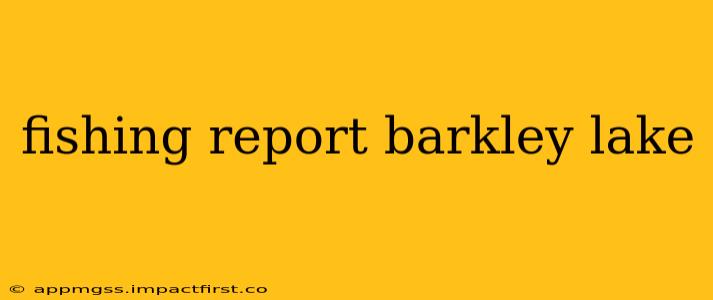Barkley Lake, a sprawling reservoir on the Cumberland River in Kentucky and Tennessee, offers anglers a diverse and exciting fishing experience. This report provides an up-to-date overview of the current fishing conditions, highlighting key species and effective techniques. Remember, fishing conditions can change rapidly, so always check local forecasts and reports before heading out.
What are the best fishing spots on Barkley Lake?
Barkley Lake boasts numerous excellent fishing spots, catering to various angling styles. Popular areas include the bays around the many coves, the main lake points, and the river channels. The specific best spot will depend on the target species and the current conditions. For example, shallow-water species like crappie often thrive in the calmer waters of the coves, while largemouth bass may be found near submerged structure along points and channels. Consulting with local bait shops or experienced anglers can provide valuable insights into the most productive areas at any given time.
What is biting on Barkley Lake right now?
The species biting on Barkley Lake varies throughout the year. Currently, [Insert Current Species and Information Here - This section needs to be updated regularly to reflect current conditions. Examples below]:
-
Largemouth Bass: Largemouth bass are generally active throughout the year, with peak activity during spring and fall. Use spinnerbaits, crankbaits, and plastic worms to target them near submerged vegetation, docks, and rocky areas.
-
Smallmouth Bass: Smallmouth bass prefer clearer water and rocky structures. They're often found near river channels and drop-offs. Jigs, tubes, and crankbaits are effective lures.
-
Crappie: Crappie fishing can be excellent, particularly in the spring and fall. Focus your efforts around brush piles, submerged trees, and docks using jigs, minnows, or small crankbaits.
-
White Bass: White bass often school in larger groups and can be targeted using techniques like trolling with spoons or diving crankbaits.
-
Catfish: Channel catfish and blue catfish are prevalent in Barkley Lake. Use stinkbaits, cut bait, or live bait fished near the bottom in deeper areas.
What is the best time of day to fish Barkley Lake?
The best time to fish Barkley Lake often depends on the species you're targeting and the time of year. However, generally, early morning and late evening hours typically offer the most productive fishing, particularly during warmer months when fish are more active during cooler periods. These times often see reduced boat traffic and calmer water conditions, leading to better opportunities.
What kind of bait is best for fishing Barkley Lake?
Barkley Lake offers a diverse ecosystem, supporting various species. The best bait will depend on the target species. Live bait such as minnows, crawfish, and worms are consistently effective for many species. Artificial lures, including spinnerbaits, crankbaits, jigs, and plastic worms, also offer excellent results, particularly for bass and crappie. Experiment with different colors and sizes to determine what works best on any given day.
What are the fishing regulations for Barkley Lake?
Before you fish, familiarize yourself with the Kentucky and Tennessee fishing regulations. These regulations include licensing requirements, size and creel limits for various species, and any special regulations for specific areas of the lake. It's crucial to adhere to these regulations to ensure responsible and sustainable fishing practices. You can find detailed information on the Kentucky Department of Fish and Wildlife Resources and the Tennessee Wildlife Resources Agency websites.
What is the current water level of Barkley Lake?
The water level of Barkley Lake fluctuates depending on rainfall and dam releases. Checking the current water level is crucial for planning your fishing trip, as it can impact access to certain areas and the depth of fishing spots. You can find up-to-date water level information from the U.S. Army Corps of Engineers website. (Note: This information needs to be updated regularly, and linking directly to a resource is beyond the scope of this prompt.)
This report provides a general overview. Remember to always check local weather forecasts, water levels, and consult with local experts for the most up-to-date information on current fishing conditions. Tight lines!
